
At 23:10 on the evening of January 31, 2024, the Solana Ecological DEFI protocol Jupiter platform currency, $ jup, also landed on the two exchanges of Binance and OKX.
>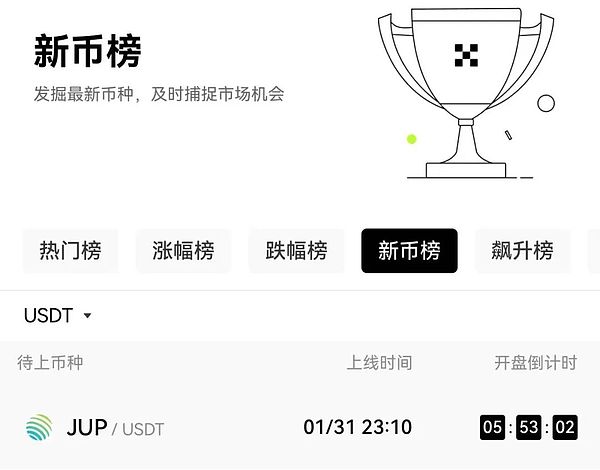
After the FTX incident, Solana’s ecological vitality was seriously injured, investment institutions were no longer favored, and well -known projects fled.In a few weeks, $ SOL plunged from $ 236 to $ 13.
>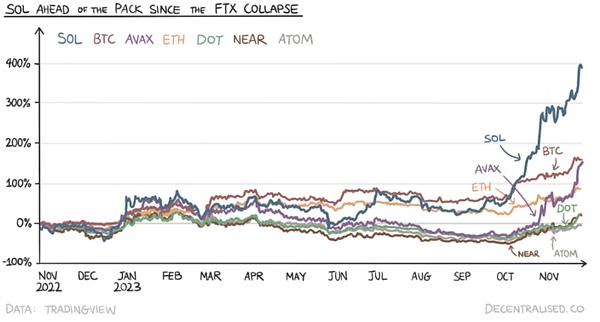
However, in 2023, Solana completed an overtake, surpassing many mainstream public chain assets.Among them, Jupiter, the leader of the Defi, also completed a ten -fold increase in monthly transaction volume, which brought $ Jup, known as “the largest airdrop in history”.
Why is $ Jup favored by the two giants?SolanaandJupiterWhat kind of future can I bring?Bai Lu’s living room this article is interpreted for you.
Knowing jupiter
Jupiter is a DEFI one -stop service platform on the Solana public chain. It was established in October 2021. The core is integrated various DEFI applications and optimized user experience.The product was originally positioned and exchanged engines, which iterated to support more related functions, such as: cost average of cost (DCA, also known as fixed investment method), price limit orders, sustainable transactions, and recently launched Launchpad.
In 2023, Jupiter’s monthly transaction volume increased by about ten times.In January, the transaction volume was US $ 650 million, and in December, it increased to $ 7.1 billion in transaction volume.After the platform announced the issuance of $ JUP tokens, the transaction volume reached a new high in November, exceeding $ 16 billion.
>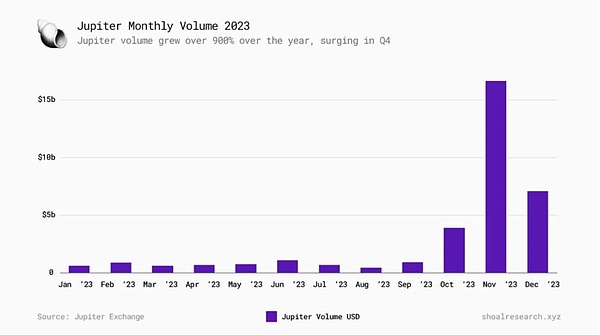
At present, Jupiter has dealt with more than $ 66.5 billion in transactions and more than 1.2 million transactions, accounting for more than 70%of the organic transaction volume of all DEXs of Solana, becoming the preferred platform for traders on Solana.
On January 26, 2024, the number of daily active addresses of Solana exceeded 1 million.For active changes, Artemis CEO publicly published a data analysis conclusion:Jupiter is the application that drives most of the most newly active addresses.
On January 26, 2024, 37%of the daily active address on Solana was the new address, which is likely to be a new wallet and new address opened by the robot to use Jupiter.
On January 28, 2024, the $ SOL-$ USDC transaction volume of $ 52.7 million on Jupiter. In addition, the transaction volume between $ wen and $ SOL and $ USDC was about 48 million US dollars.
>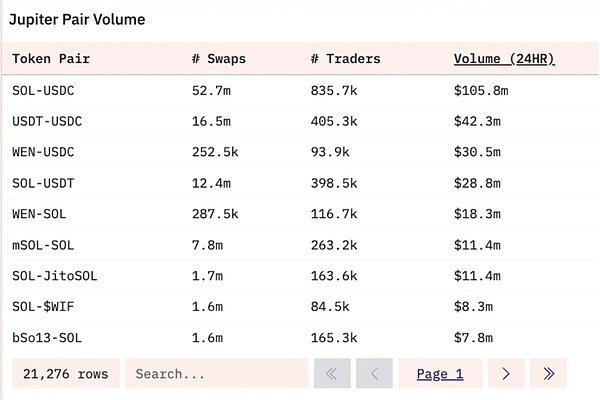
On January 31, the first phase of $ JUP was officially issued. The market attention was unprecedentedly hot. Solana’s most watched in history and the largest number of potential airdrops kicked off.
$ Jup
The maximum supply of $ JUP is 10 billion, and the tokens are distributed to 2 cold wallets: team wallets and community wallets.Team wallets will be used to distribute to the current team, finance and liquidity, while community wallets are used for airdrops and various early contributors.
>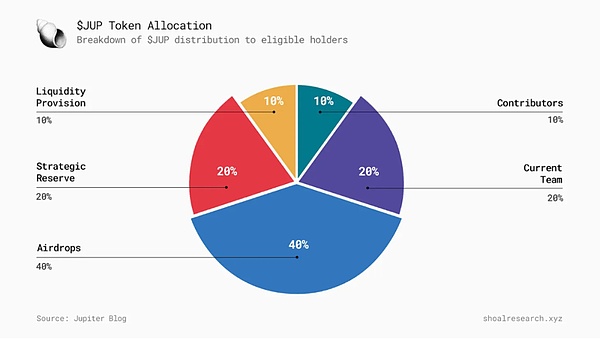
From the first day, 15%-17.5%of tokens have begun to circulate, 10%-7.5%are located in hot wallets, and 75%are located in cold wallets.
Jupiter will be traced on the 955,000 early users (the deadline before November 2, 2023), and aimed at attracting new users and liquidity.Then, DAO will vote on the token unlocking data, the tokens will be initially locked, and the unlocking date will be set by DAO.Jup holders will be able to vote for the key aspects of the Jupiter protocol and the role of tokens, including the time provided by the initial liquidity, future emission arrangements, the project will be displayed on the Jupiter Start, and so on.
$ Jup can get such a high attention, the bottom of the bottom,It is Jupiter’s advantage to play solanda and its potential for continuously innovating DEFI.
SVM -based construction is more suitable for Dex development
Virtual machines can be described as a single entity for thousands of operating specific chains (such as Ethereum) to verify the client’s connected computer maintenance. It is an environment where all smart contracts and accounts are actually existed.To this day, most DEFI and other chain activities are performed through Ethereum virtual machines (EVM).
However, although SVM is no longer under the spotlight, SVM also has a strong structure, and it will definitely continue to attract more developers who seek more consumers and optimize applications for consumers.
Smart contract code written with Rust, C, C ++ will be compiled into BPF bytecode by SVM.The Sealevel engine is a key component implemented on parallel processing on Solana; as the Solana transaction integrates a status access list, the unconflaced transactions can run at the same time, thereby achieving faster overall performance.
On the other hand, the average interaction cost of Solana is low.GAS cost less than a penny.The cost of obtaining liquidity from multiple sources is almost the same as from one source, soThe DEX polymer is more practical and beneficial than the EVM chain on the chain.
As a leading polymer on Solana, Jupiter is expected to achieve significant growth and adoption in the long run, and the polymer on the EVM chain faces higher costs and greater competition.
The same concept is also applicable to other use cases other than B replacing B, such as providing users with a structured US dollar cost average method (DCA) or time weighted average price (TWAP) products.
More imaginative DEX development direction
Jupiter combines the innovative function of DEX on a large number of DEX on the chain to create the smoothest trading experience for users, and also provides a good example for Defi’s future development direction.
AMM and polymer
Automatization Municipal merchants have been a novel innovation in the field of digital assets in the past few years.With the emergence of AMM, traders can deploy digital assets from mathematics and code rather than complicated middlemen manufacturing markets.Even in the case of extremely low liquidity, traders can enter and exit.
Of course, low liquidity will bring new shortcomings.First, traders will encounter a sliding point, that is, the difference between the expected transaction value and the realization of the transaction value; the second is that traders may also lose the value in transactions through the asymmetric use of information in public Mempool, such as being deployed by MEV robots deployed by MEV robotsComplex participants grab or pinch.These also require developers to overcome more.
The appearance of the polymer on the chain is to reduce the impact of low liquidity transactions, so that traders can place orders, from multiple sources rather than a source to transmit liquidity.Lobricity can be obtained from a variety of sources, including AMM.Jupiter and other DEX aggregates obtain liquidity across multiple trading venues, thereby providing traders with better trading prices and a better user experience.
DCA
The average cost method DCA, also known as fixed investment, involves the distribution of capital into multiple transactions, not a transaction.When DCA accumulates assets in the bear market, its own entry price is on average to reduce volatility and get greater returns in the process of changes in time and market conditions.Similarly, DCA can also help profit in the bull market. Unlike immediately selling its own positions, DCA can help decentralized sales to capture any additional increase space that may occur during the liquidation, rather than immediately selling the positions.
Traders can also implement the weighted average price strategy, that is, TWAP to purchase or sell assets.Similar to DCA, TWAP is usually used to split large -scale orders to be split into small parts to prevent price effects caused by one -time purchase.
Because Solana has a high -throughput architecture, Jupiter is one of the few platforms that allow users to perform frequent time -limited strategies on the chain.DCA (such as daily), which is traded at a low time range on Ethereum, may lead to hundreds of dollars of trading costs, and only a few cents on Solana.Even on L2, if traders want 10 transactions within 1 hour, the cost will increase quickly.
Sustainable contract
Jupiter launched the LP-Traders permanent contract exchange.Although it is still in the test stage, traders can use up to 100 times the leverage trading SOL, ETH, and WBTC perpetual contracts, while LP can provide capital to earn costs.
On Jupiter, traders can use almost any supported Solana tokens as mortgages, and open long or short positions on SOL, ETH, and WBTC.The multi -header requires the corresponding target, and the short position requires stable currency as a mortgage.Traders can assume leverage by borrowing assets from the liquidity pool -the lever rate of SOL -USD position by borrowing 1 times from the JLP pool can be doubled.
Jupiter Perps uses the JLP pool that includes SOL, ETH, WBTC, USDC, and USDT.It only needs to deposit any supported Solana token in the JLP pool to exchange for the $ JLP tokens for equivalent.The JLP pool has obtained a 70%cost generated by the Jupiter perpetual contract, and the price of $ JLP has grown synchronously with the value of the basic pool.
The JLP pool is also beneficial to the larger Solana ecosystem, because the Jupiter Swap has been integrated to a sustainable contract exchange locally, which means that not only can it be used as a JLP mortgage, but also solana traders can increase from the JLP pool from the JLP poolBenefit in liquidity and get better transaction prices.
Unlike the aforementioned features, Jupiter’s permanent contract exchange charge more fees to traders and LP.The trader pays the pool fee to the pool according to the cost of the borrowing fee or funding rate of each hour. The rate is based on the per -hour borrowing rate, the size and the tokens, which can be expressed as:
Fundamental rate = (tokens in the borrowed tokens/pool)*0.01%*position size
LP also needs to pay some of its own fees for opening the position/closing position and exchanging different assets in the JLP pool.
Jupiter is a feasible bet that Solana has recently adopted.With the increasing network activities on Solana, Jupiter may capture a lot of liquidity through its established ecosystems, various product kits, and sustainable income models. Theoretically, the $ Jup holders will benefit from it for a long time.In the context of the increasing attention of mainstream financial giants today, the leading leader of Jupiter’s functional innovation is likely to be the first opportunity for the new generation of DEFI markets.








